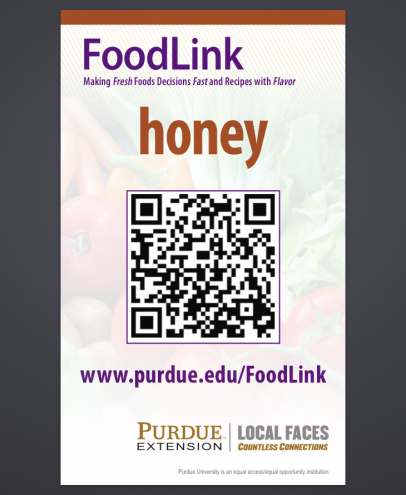FoodLink: Making Food Decisions Fast
Next time you find yourself in a grocery store, take a look at the considerable marketing inflicted upon shoppers. Look at the packaging. Notice the bright colors, shapes, motivating images, serving suggestions and, yes, sometimes even cartoon characters and prominent personalities that urge you to buy their product.
Interestingly enough, there is a relative void of these motivators when it comes to fruits and vegetables. Produce displays are clean, attractive and brightly lit, but these fresh and presumably healthful products must largely sell themselves on their own appearance and reputation. And while various well-meaning, helpful and science-based campaigns such as Fruits & Veggies—More Matters, My Plate and Let's Move might encourage shoppers to consume more servings of fruit and vegetables, I have to wonder how busy shoppers will respond at the point of purchase—especially when rapid decisions must be made among a continuum of choices.
In May 2013 I had the opportunity to hear a presentation at the National Value Added Conference entitled “Retailer Local Food System Strategies,” presented by the senior director for issue management and strategic outreach of the country’s largest grocery-store chain. He emphasized that more and more, shoppers need to make many rapid food purchasing decisions, which involve a multitude of variables including price, longevity, nutrition and health. He also noted consumers are looking for ways to prepare good meals fast and will increasingly seek and use their smartphone to help.
“As we look to the future,” he stressed, “digital means a lot!” And his comments made me wonder how—how will digital mean a lot in the future?
Sometime later I attended a training class on how to make a digital connection from an educational perspective. One of the sessions was focused on Quick Response (QR) codes, those typically black-and-white squares that look a bit like a small crossword puzzle and show up in a variety of places. And I learned that 87 percent of women with children have a smartphone capable of accessing QR codes at the point of purchase. It was at that moment, when I considered the compatibility of the two, that FoodLink was born.
Good idea, good food
FoodLink at its most basic is a free decision-making tool that links the busy consumer who cares about making the best choices—not necessarily the simplest choice—among the complex range of food possibilities that face them day in and day out.
Over 50 commonly grown fruits, vegetables, specialty crops, herbs and even honey now have available a unique FoodLink QR code directly associated with the product display, related signage or promotions. When scanned with a smartphone, the screen will show basic information about the specific crop, all within three to five seconds. The user can then use the information to make an informed decision about the product they’re considering for purchase.
The goal of FoodLink is to increase awareness, generate discussion and to foster good food decision making and encourage and empower busy shoppers, perhaps with minimal training or food-related experience, to begin to incorporate healthful, fresh food into their family’s diet. And if we can make this experience an easy, positive and delicious one, it’s more likely to be repeated.
What FoodLink can teach you about the food you buy
If you don’t know how to prepare green beans in a way your family would eat and enjoy, would you purchase green beans? What about kale? What about kohlrabi? Probably not, but that’s where FoodLink comes in.
FoodLink recipes have been carefully selected for ease of use, minimal ingredients and a high potential for success—meaning even the kids will eat their greens. And the embedded YouTube videos offer brief visual tutorials about basic food preparation, like how to peel an apple, cut up a melon, etc. For those wishing to extend their culinary horizons, most entries have links to Pinterest that offer an almost limitless array of possible ways to incorporate fresh products into the family diet.
But FoodLink does more than suggest new ways to make green beans—or kohlrabi, for that matter. It teaches the consumer what’s inside the food, where it comes from and why it’s good for you. Basically, that little QR code gives the consumer additional information that supports good food-decision making. So next time you’re considering purchasing something you can’t pronounce, let alone cook, find the QR code, give it a scan and watch as a whole new world of culinary options unfolds before your eyes.
What’s in a FoodLink QR code?
- Nutritional content
- Photos of the item as harvested
- Seasonal availability
- Relevant selection information
- Basic prep and cooking tips
- Storage, short- and long-term
- Pairings with other seasonally available foods
- Recipes
- Links to YouTube videos to illustrate basic use, preparation and storage techniques
FoodLink has been in development since 2014 with cooperation of many talented folks from across Purdue Extension programs and within Purdue Ag Communications. It was released for the 2016 growing season and its growth and development is ongoing based upon feedback from users. It is currently in use in farmers markets, roadside stands, on farm markets and grocery stores in 62 of Indiana’s counties and its information has been accessed from all 50 states and beyond. Additionally, a USDA Specialty Crop Block Grant provides ongoing support, development and outreach including new crops and recipes, a collector recipe-card series, a greater farm-to-school focus and a number of cooking demonstrations across Indiana.







